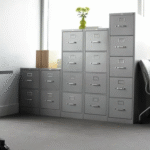
In today’s fast-paced business environment, the conference room has become more than just a place for meetings. It serves as a hub for collaboration, brainstorming, and decision-making. At the center of this space lies the conference table, a piece of furniture that holds both functional and aesthetic value. Choosing the right conference table design can transform the atmosphere of a workplace, foster creativity, and encourage seamless communication among employees. Modern businesses now look at the conference table as a strategic investment that represents professionalism while enhancing efficiency.
Importance Of Conference Table Design In The Workplace
The design of a conference table directly influences how people engage in discussions. A poorly designed table can make participants feel cramped, uncomfortable, or disconnected, while a well-planned design enhances communication flow and ensures everyone feels included. Conference table design also reflects the values of a company. For example, sleek and minimalist tables showcase a brand’s forward-thinking approach, while traditional wooden tables communicate authority and stability. Beyond aesthetics, it is essential to consider ergonomics, technology integration, and spatial arrangement when selecting the right table for a meeting room.
Different Shapes Of Conference Table Design
One of the most significant factors when choosing a conference table is its shape, as it sets the tone for meetings. Rectangular tables remain the most popular choice, offering a classic layout suitable for both formal and casual discussions. Oval or elliptical tables provide a softer look, improving visibility and communication by removing sharp edges. Round conference table designs promote equality by giving every participant the same position, making them perfect for collaborative sessions. U-shaped and boat-shaped designs, on the other hand, create a balance between authority and inclusiveness, often favored in large organizations where presentations are frequent.
Materials That Define Conference Table Design
The material of a conference table can dramatically affect the overall look and durability. Solid wood remains a timeless option, valued for its elegance and strength. However, modern workplaces are experimenting with glass tops, which provide a sleek and contemporary feel while making small rooms appear more spacious. Laminate and engineered wood are cost-effective alternatives that offer versatility in color and finish. Metal accents or mixed-material conference table designs also bring a modern industrial vibe to offices, perfectly aligning with today’s trendy workspaces. Choosing the right material depends not only on style but also on long-term maintenance and budget.
Technology Integration In Conference Table Design
With the rise of digital communication, a modern conference table must accommodate technological needs. Built-in cable management systems, wireless charging ports, and integrated power outlets are now considered essential. Some designs also feature embedded screens, microphone setups, or video conferencing tools that allow hybrid teams to collaborate effectively. A tech-friendly conference table design ensures a clutter-free environment, keeping meetings focused and productive. As remote work becomes more common, having seamless connectivity in the conference room creates a bridge between in-office and remote employees, reinforcing teamwork.
Balancing Size And Space In Conference Table Design
The size of a conference table should align with the dimensions of the meeting room. A table that is too large may overwhelm the space and make it difficult for people to move around, while a small table may not accommodate the necessary number of participants. Ideally, there should be enough clearance for chairs to slide back comfortably and for people to walk without obstruction. Designers recommend leaving at least three feet of clearance around the table for optimal comfort. A well-proportioned conference table design not only enhances the usability of the space but also prevents meetings from feeling overcrowded.
Ergonomics And Comfort In Conference Table Design
While aesthetics are crucial, ergonomics should never be overlooked. The height of a conference table must be suitable for both writing and laptop use. Chairs paired with the table should provide adequate lumbar support to maintain comfort during long discussions. Rounded edges, soft finishes, and easy-to-clean surfaces are also practical considerations. A well-thought-out conference table design ensures that participants remain focused and engaged without being distracted by physical discomfort. This balance of style and functionality makes the workspace truly effective.
Customization Options In Conference Table Design
Every business has unique requirements, which is why customization has become a growing trend. Companies now opt for conference table designs tailored to their brand identity and office culture. This includes choosing specific finishes, incorporating company logos, or adjusting dimensions to fit unconventional spaces. Modular tables are also gaining popularity, as they can be rearranged depending on the size and nature of the meeting. Customization ensures that the conference table is not just furniture but an extension of a company’s values and vision.
How Conference Table Design Impacts Company Culture
The conference table often sets the mood for decision-making and collaboration. A bold and contemporary design can inspire innovation, while a traditional and authoritative table reinforces hierarchy and professionalism. In creative industries, informal and dynamic designs encourage free-flowing ideas, while in corporate settings, structured designs promote order and discipline. Employees are more likely to feel valued when they are seated around a well-designed table that accommodates everyone equally. Ultimately, the right conference table design contributes to building a culture of inclusivity, respect, and productivity.
Conclusion On Choosing The Right Conference Table Design
Investing in the right conference table is about more than just aesthetics. It involves understanding the unique needs of a workplace, from size and shape to material and technology integration. A thoughtfully designed conference table enhances collaboration, strengthens communication, and reflects the identity of the organization. As workspaces continue to evolve, so too will conference table designs, adapting to modern business requirements. By choosing carefully, companies ensure their meeting rooms become productive spaces where ideas flourish and strategies take shape. For businesses looking to combine functionality with elegance, Office furniture provides the ideal solutions that align with both style and efficiency.

